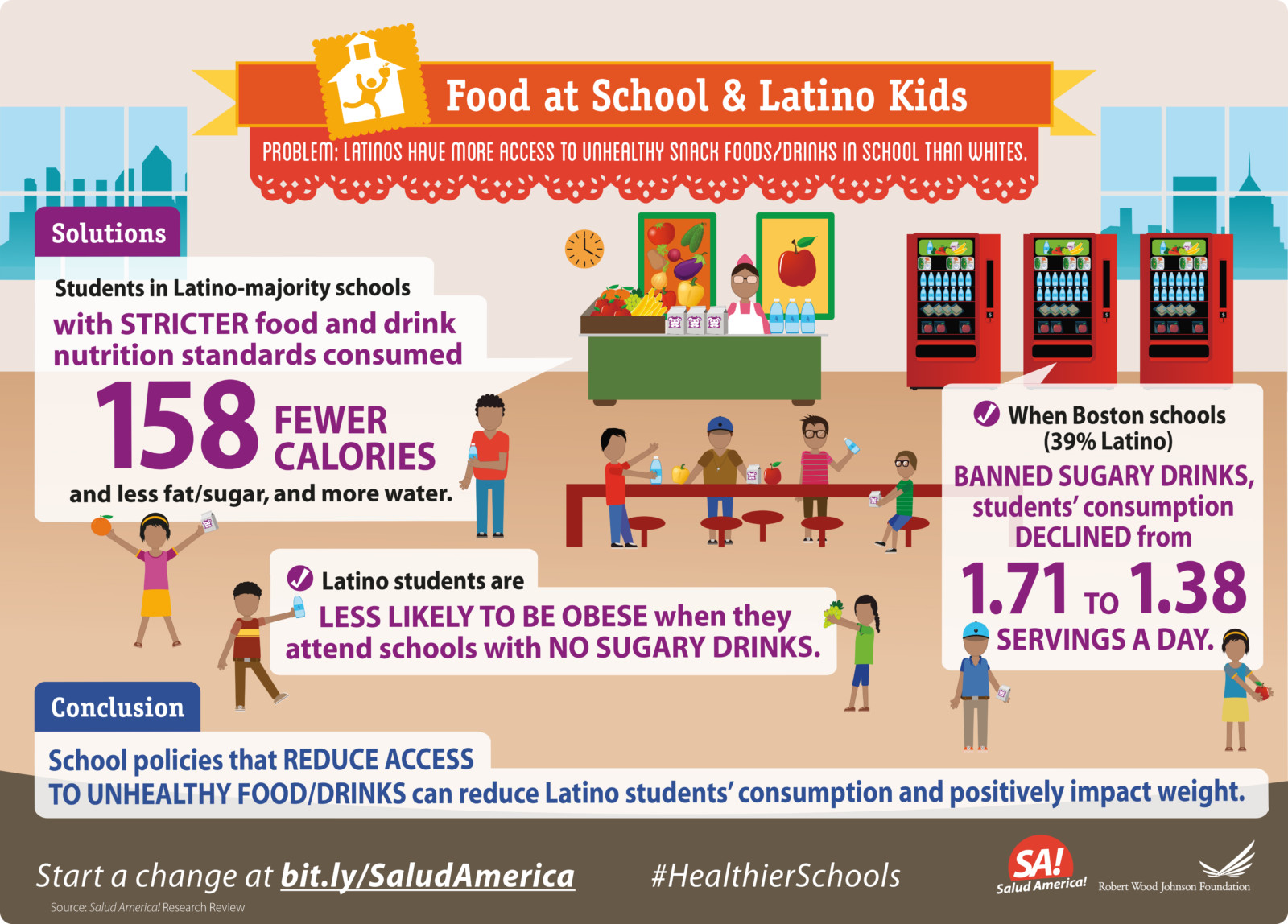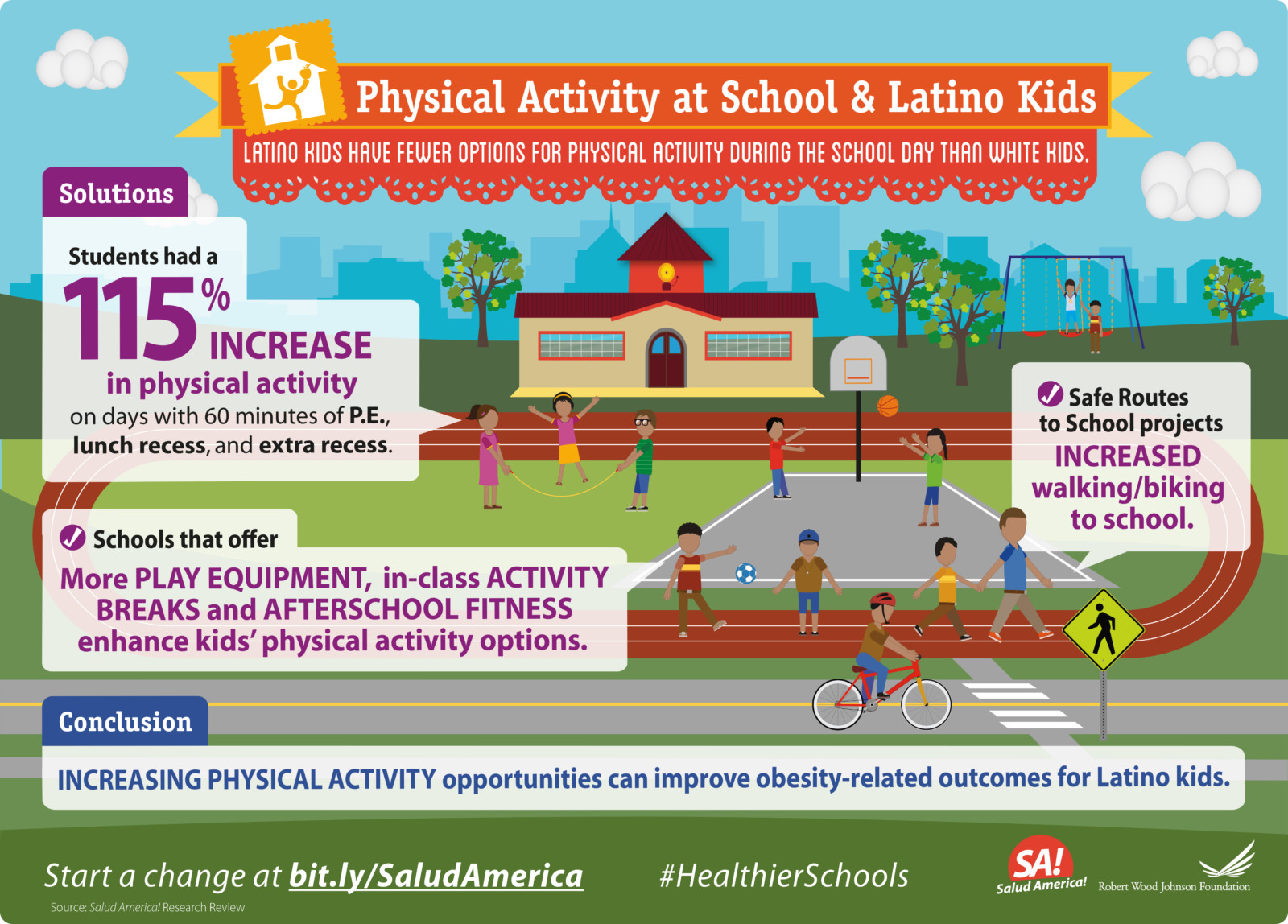Share On Social!
Abstract
Latino kids need a healthy school environment, especially given that 1 in 3 public school children will be Latino in a few years.
How can we healthy schools become then norm?
Latino students are more exposed to unhealthy food in and out of school. Stronger nutrition standards for snack foods and drinks will help Latino and all students access to healthier snacks at school, which can positively influence body mass index (BMI) trends for all populations.
Latino students also engage in less physical activity than their peers in school, and before and after school. Implementing culturally relevant programs that reduce barriers can increase activity opportunities for Latino kids.
Read the Issue Brief in English (PDF)
Read the Issue Brief in Spanish (PDF)
Contents
Introduction & Methods. This Salud America! research review is an assessment of available research about the physical activity and competitive food environment and their impact on the health of students in largely Latino schools. The review also summarizes the evidence on policy and program solutions to increase access to physical activity and healthy food for Latino students.
Key Research Findings

School food environment. Latinos have more access than whites to unhealthy foods and drinks in school stores, snack lines, and vending machines. Latino students ate or drank 47 more “low-nutrient” calories per day than their peers.
School food policies. Schools with more Latino students tend to have weaker policies for school snacks and drinks.
Stricter food and drink nutrition standards in a mostly Latino school led to students consuming 158 fewer calories, less fat and sugar, and more water. Latino students are less likely to be obese when schools allow no sugary drinks.

Physical activity. Latino-majority elementary schools were less likely than white schools to offer 20 minutes of recess a day or P.E. for 150 minutes a week. Latinos kids have the lowest participation rates in organized sports/afterschool programs.
Access to activity programs. Fifth-graders had a 115% increase in physical activity on days with a 30-min P.E. class, 20-min lunch recess, and extra 10-min recess. Schools can offer classroom activity breaks, enhance school yards, and provide equipment.
Latino kids in afterschool fitness programs were 10% more likely to be fit two years later than non-participants. Safe Routes to School improvement projects increased Latino kids’ walking and biking to school.
Conclusions
Policy Implications. School policy and decision makers should prioritize helping schools in Latino communities effectively implement federal nutrition standards, and consider nutritional education that covers schools and the surrounding food environment. They also should develop culturally relevant structured programs, less-structured activities (in-class brain breaks, enhanced schoolyards), and afterschool programs to increase Latino children’s physical activity levels.
Future Research Needs. Additional research is needed to understand how the food and drink environment in and around schools impact the health of Latino students. Also, as federal school nutrition standards continue to be updated, future research should focus on the effects of these changes on Latino child health. Future research also is needed to identify the factors that may support or block Latino children’s physical activity—like family income, or availability of recreational facilities of resources—and how to increase physical activity among this population.
References
See the Full Research Review with references (PDF)
About the Authors
- Amelie G. Ramirez, Dr.P.H., Director, Salud America!, Professor, Institute for Health Promotion Research, UT Health San Antonio
- Kipling J. Gallion, M.A., Deputy Director, Salud America!, Assistant Professor, Institute for Health Promotion Research, UT Health San Antonio
- Erin Surette Dembeck, P.A. (ASCP)
- Carolyn K. Beam, Ph.D., Beam Medical Communications, LLC
- Jennifer Swanson, M.E., JS Medical Communications, LLC
This report is copyright 2017 RWJF, Route 1 and College Road, P.O. Box 2316, Princeton, NJ, 08543-2316, www.rwjf.org.
Explore More:
Healthy Families & SchoolsBy The Numbers
142
Percent
Expected rise in Latino cancer cases in coming years



